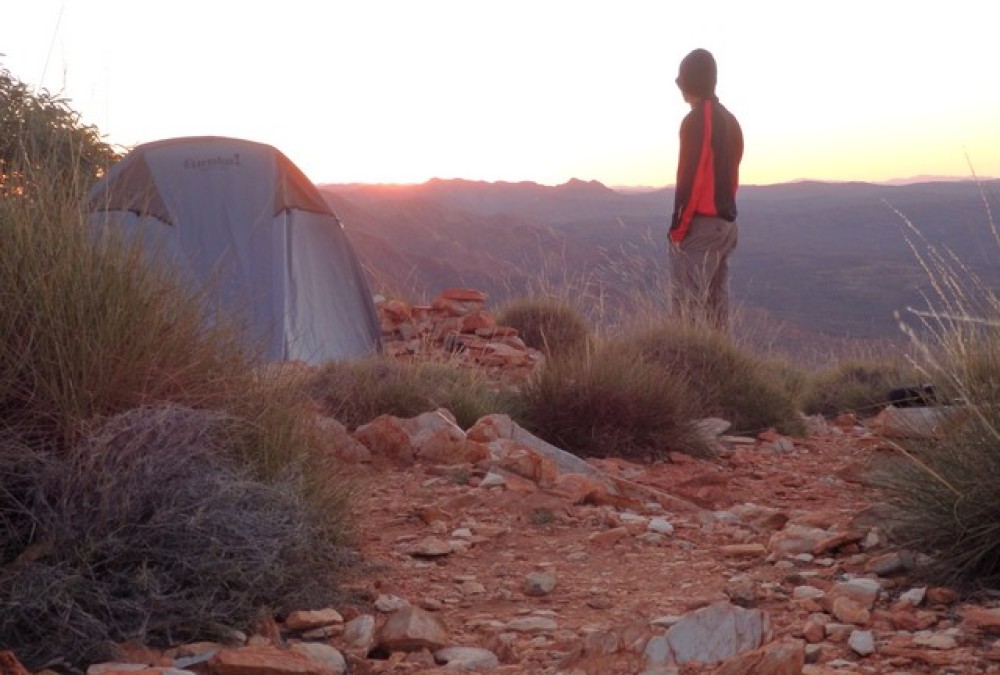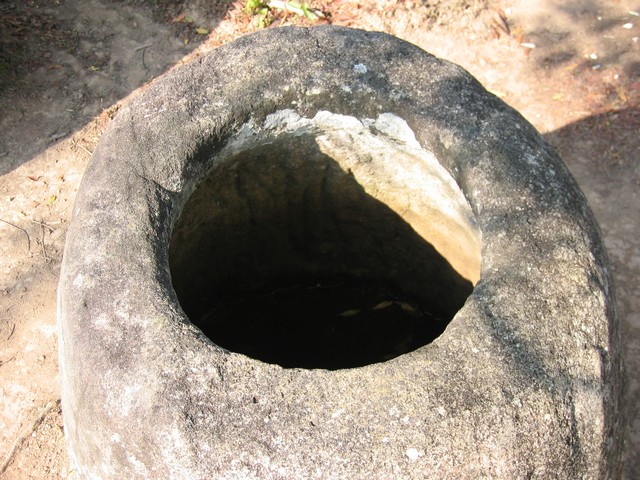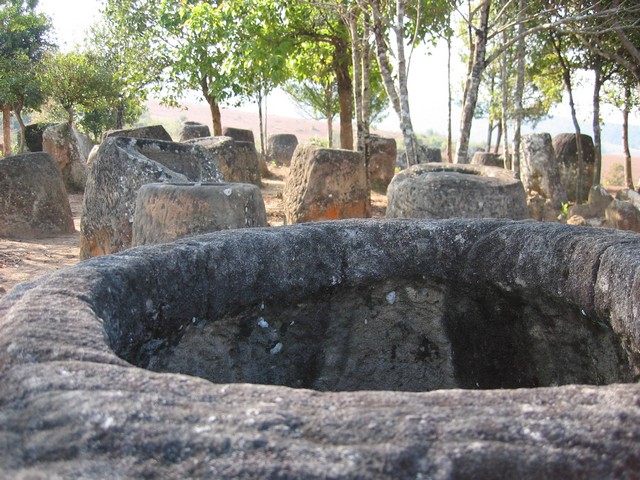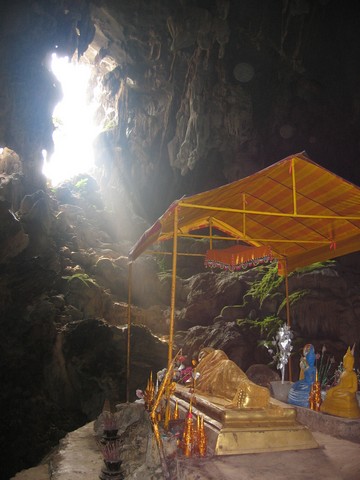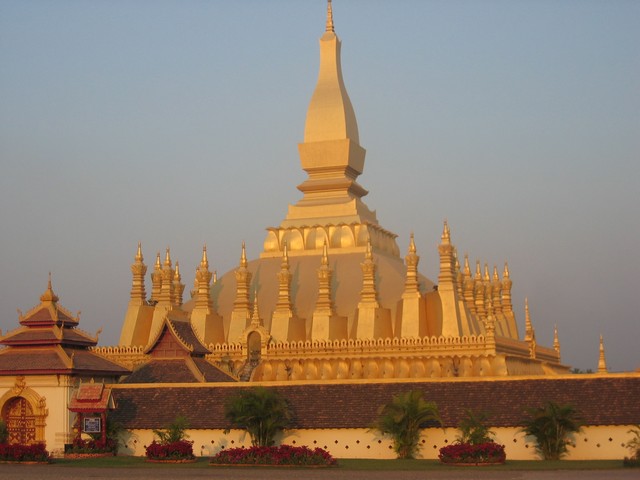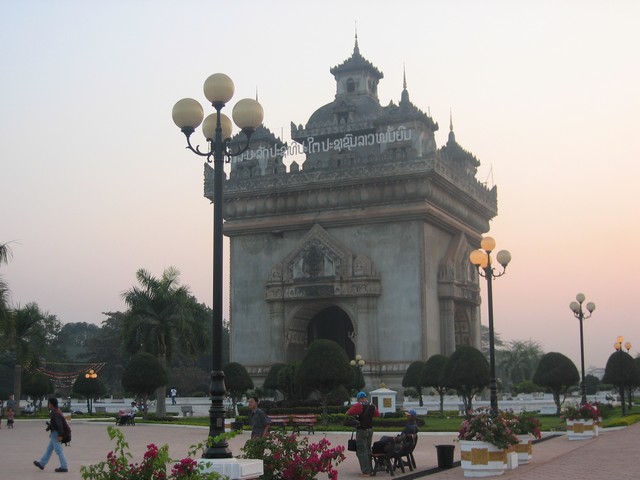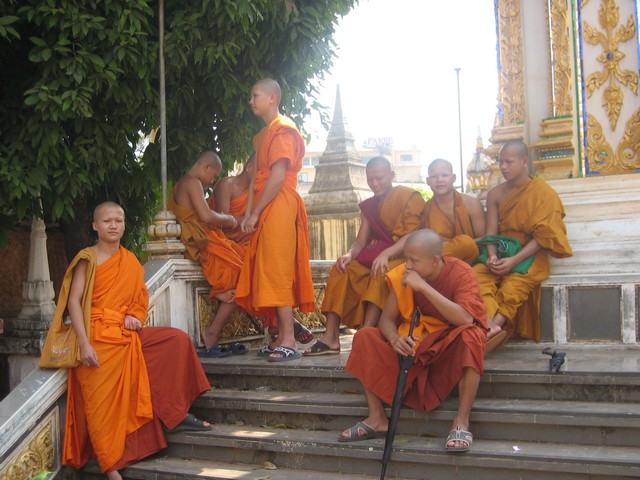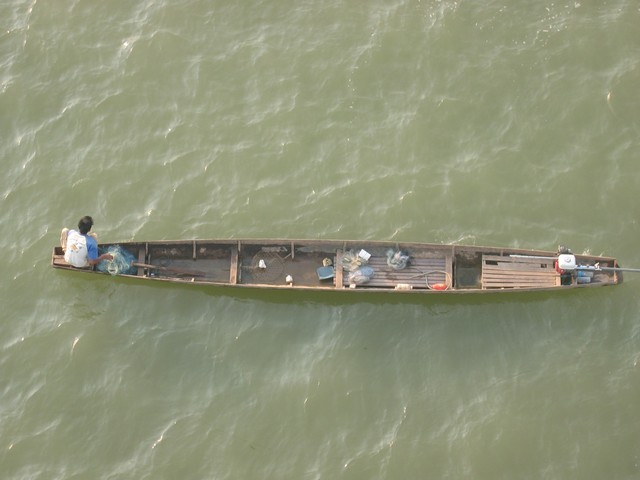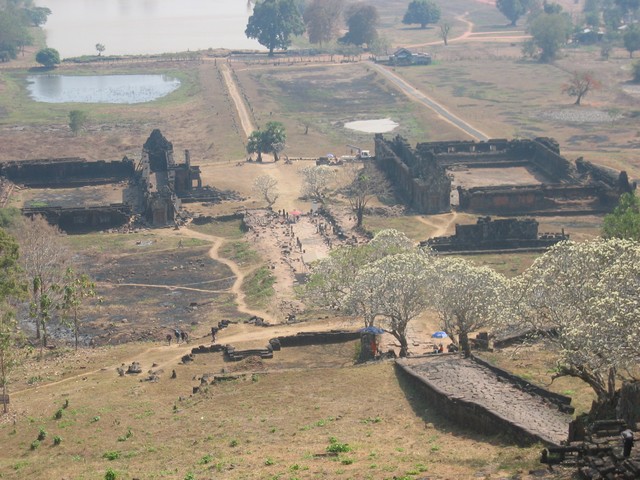Almost immediately after crossing the Mekong River separating Thailand from Laos, I feel more relaxed. Whether it’s the people, the noticeable change in traffic; I can’t put a finger on it, but I celebrate my return to the country with what could be the worlds best beer – Beer Laos!
MEKONG RIVER – LUANG PRABANG, LAOS
It’s a two-day trip down the Mekong River to Luang Prabang on the slow boat. The boat – essentially an oversized wooden canoe with a roof – is not particularly comfortable, offering little protection from the elements. However is an excellent opportunity to not only form friendships with your fellow passengers, but to observe people and wildlife alongside one of Asia’s great rivers.
Luang Prabang is the jewel in Laos’ tourist crown, and as I disembark from the boat and walk up the steep river bank into town, I smile as one would when seeing an old friend again after a long absence. Speaking of old friends – I again meet up with Hans, he having arrived the same day on another boat.
Two days and nights relaxing in Luang Prabang and I was ready to again explore. This time I was determined to take ‘the road less travelled’ and visit some of the far-flung corners of the country – starting with an eight-hour bus trip to Phonsovan.
PHONSOVAN – XAM NUA, LAOS
Surrounding Phonsovan are numerous sites consisting of huge stone ‘jars’; some of the sites have several hundred of these amazing artifacts. The jars – looking like giant vases – are astonishing and incredibly mysterious:
- Some are 2 metres high and 2 metres in diameter. Each made from solid rock – I assume granite – and weigh up to 3 tonnes.
- Approx 1500 years old.
- The inside of each jar has been carved out to leave an incredibly smooth surface.
- At one of the sites they found a nearby quarry from where the jars originated from. The quarry is quite some way downhill from they are now located. They would be difficult to move that far uphill today, let alone then.
- There is no evidence to determine with any great certainly what the purpose of the jars were. The most likely scenario is they were used to cremate the dead.
- They are found nowhere else.
Thanks to the USA and allied forces who carpeted the area with bombs during the Vietnam War, many of the jars have been destroyed and only three sites are considered safe to visit.
I observe the Mine Advisory Group (MAG) at one site clearing an area of bombies using metal detectors.
(Each bomb dropped held about 700 cricket ball sized bombies and each bombie is filled with ball bearings. It is estimated over a 100 million bombies landed on Laos, but some 30 % never exploded on impact and even some 30 years later are responsible for nearly one death per day. I met someone working for a NGO who is trying to encourage the locals to use shovels instead of hoes/mattocks to work the fields. Using a shovel is far less likely to cause an explosion). I couldn’t help but take a closer look at the MAG guys, who on hearing the metal detector ‘beep’, starting digging with garden tools. Observing over their shoulder as they dig towards the offending target, I’m pulled away by my guide who brought me here. He informs me of a recent incident where eight MAG staff were killed on detonation of a buried bombie. These guys are paid approx $200 per month – a substantial sum in Laos.
Perusing the map and in keeping with my ‘road less travelled’ edict I find Xam Nua, a town located in the far north-west of Laos close to the border with Vietnam. There is no immigration office at the nearby border, although there is talk that may be changing in the ensuing weeks/months, which would open it to a wave of tourists coming from Hanoi. The seven hour trip there in the back of a utility – with two Swedes and an American – was incredibly cold and uncomfortable.
Xam Nua has one establishment with an English menu, all other attempts at food or even arranging our accommodation were done via sign language. A lady at the bus station spoke English. So did the police officer who insisted I join him and his buddies drinking Laos Laos whisky and grabbing me by the shirt to pull me back to my seat every time I attempted to leave; they were hilarious, but the insidious whisky had me on the verge of vomiting.
Also a guide at a nearby village who offers tours to the caves used by the Laos army and government officials during the Vietnam War. He was an excellent guide and the tour surprised all of us with extent of the cave network. He was genuinely excited at our visit and the opportunity to practice his English as he gets very few foreigners.
I booked a bus seat for the return journey to Phonsovan, a more comfortable – and warmer – option than the utility; or so I thought. Much to everyone’s amusement, I was the only foreigner on the 40 seater bus, which was carrying 70-75 people – not including chickens and pigs! Separating Xam Nua from Phonsovan is a seemingly endless mountain range and so as the road snakes its way through, someone inevitably succumbs to motion sickness and like a wave it spreads its way through the bus until the smell of vomit seems to cross senses and one can seemingly taste it. Seems this was not enough of a test, so throw in two lengthly stops to repair a flat tyre and a dodgy radiator.
I’ve had some ‘fun’ bus trips in Asia, but this was the new benchmark. Fortunately for my 12 hours of travel I was soothed with loud screeching Asian karaoke music from the TV. This was the VIP bus! I laughed on exiting the bus at Phonsovan. If it was easy everyone would be doing it.
VANG VIENG – VIENTIANE, LAOS
Five minutes after arriving in Vang Vieng, who should I run into – Hans! Two days of movie watching, western food, drinks by the riverside bars and swimming.
Rather than a return bus trip to Vientiane, I kayak. Doesn’t offer a lot for the thrillseeker in terms of fast rapids, but an opportunity for a cliff jump into the river and a far more enjoyable alternative to the road.
The 11.00 pm curfew on bars in Vientiane is somewhat irritating, but took the opportunity to explore the city some more, including the striking and beautiful Pha That Luang Temple.
PAKSE – ATTAPEU – CHAMPANSAK, LAOS
Southern Laos is discernibly different to the north. The topography has little to offer in the way of majestic mountain ranges, has less precipitation, and higher temperatures. Consequently the tourist populace is considerably less and more likely to be French in nationality.
Pakse is an ideal place to base yourself with a central location in the south and its aging French architecture, on the banks of the Mekong River.
From here I hired a motorbike and explored to the east. The guesthouse and waterfalls at Tat Lo looked very welcoming, but the waterfall at Tadfane was truly spectacular as it crashed off the edge of the Bolaven Plateau.
Attapeu in the south-eastern corner of the country is as far as I could travel via bus. On arrival – and realising virtually no-one spoke English – I pondered the wisdom of my decision to travel here. The Ho Chi Minh Trail is near here and I was keen to see and walk the trail; but there were no other tourists, only two guesthouses and the government office where one might hire a guide was closed as I had arrived on the weekend.
My guesthouse owner sensing my disappointment, came to the rescue and introduced me to a friend of his – Ket. Ket was a solid built man about the same age as myself and to my immediate surprise, introduced himself with a strong handshake and a cheerful “G’day!”
Ket is employed with the agriculture department assisting locals in improving crop yields etc, however prior to this was working for an Australian utilizing Australian funding to either disarm or execute controlled explosions of uxo’s (unexploded ordanents).
For USD$10, Ket agreed to take a day out of his weekend and utilizing his trailbike, we explored nearby villages and some of his favourite haunts including a still intact 6 metre Russian missile; walked a section of the Ho Chi Minh Trail, even helped push a truck stuck in the mud.
Ket’s English and expertise of the area was impressive, as was his knowledge of the issues facing the people here, particularly with regards to the uxo’s. This area was heavily bombed during the Vietnam War and the people here so poor that scrap metal from the bombs are sold to supplement income. Unfortunately a lot of the metal comes from live and intact bombs, resulting in continuing high casualties. Ket himself has lost three friends to these forgotten remnants of the past.
The opportunity to spend a day with someone like Ket with his knowledge and experience what few others have seen, has been a definite highlight. On our return to Attapeu we paid a visit to the towns only bar for a few beers, after which, and with the dubious permission of his very pregnant wife, we absconded to his mates place for a few more.
The lack of English spoken here has made getting a meal somewhat difficult. Eating amounts to entering an eatery and either pointing at what someone else is eating or as what happened on one occasion, being led into the kitchen to choose from something from the 5-6 large pots simmering away on the stove. Quite a humbling experience.
The return bus stops soon after leaving Attapeu to load dozens of chaff size bags of scrap metal, so many in fact, they were stacked about head height down the aisle of the bus. I’ve learnt a little of the language which is warmly appreciated and enables some amusing conversations – albeit basic – with any University students on the bus.
Champansak is a small spread out village – again on the banks of the Mekong River. The flat topography is ideal for hiring a pushbike and exploring the nearby ancient Angkor period ruins at Wat Phu Champasak.
Returning to Pakse, I again hire a motorbike and spend my last night in Laos at Pasuam waterfall. The waterfall is superb, a beautiful horseshoe-shaped 8-10 metre high rock wall with water cascading over and into a deep – perfect for swimming – waterhole. Overlooking all this is a newly built timber bar/restaurant and eco style huts for accommodation; it’s not in the LP guidebook, but soon will be. My accommodation was a treehouse about five metres off the ground, centrally located in the middle of the adjoining village. An amazing feeling sleeping that high up and with no other tourists, the very friendly staff kept me busy practising their English.
LAOS PDR – Peoples Democratic Republic. I think it might actually mean Please Don’t Rush!
Link to my photo site:
http://www.flickr.com/photos/danthewanderer/sets/
THANK YOU FOR READING. COULD I ASK A FAVOUR? If you found this story interesting or useful enough for others to see, please share our love of the great outdoors and this beautiful planet via your social media - it all helps:
